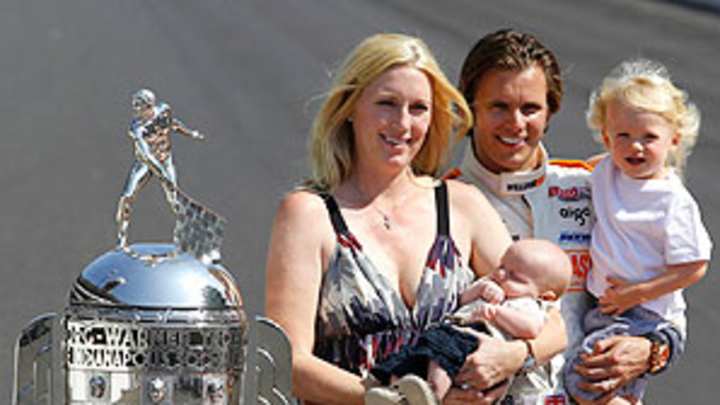The charismatic Dan Wheldon left a gaping void still present in IndyCar

These moments in this room are usually the most intense in all of American motorsports -- the final calm before the engines fire and the cars hurtle around the Brickyard at 225 mph in what is always the biggest single race of the year -- and Wheldon wanted to be in here to represent her husband, the reigning race winner at Indy. Watching Wheldon kiss the cheek of Scott Dixon that afternoon before Dixon walked out into the brilliant Indiana sunshine, it was impossible not to think of Dan, of how Susie had held his hand in this room one year earlier.
"Dan loved the Indianapolis Motor Speedway," Susie said, "and what it meant to win here."
It was one year ago on Tuesday, Oct. 16 that Wheldon, a two-time champ at Indy, died in a crash at Las Vegas Motor Speedway. That weekend in Las Vegas Wheldon, at age 33, was on the threshold of rebuilding his racing career. After winning the Indy 500 in May 2011 in a part-time ride, he had competed in only one other IndyCar event. But then Randy Bernard, the CEO of IndyCar, offered Wheldon what seemed like a gift: If Wheldon would start in the back of the field at Las Vegas in the season finale on Oct. 16, Bernard would give him $2.5 million and $2.5 million to a fan picked at random. This was strictly a marketing gimmick for a struggling series, but Wheldon accepted. And then, just hours before he hopped into his car, Wheldon received what he was really hoping to win at Las Vegas: a contract offer from Andretti Autosport for a fulltime ride for 2012.
But even if Andretti had never reached out to him, Wheldon would have been a happy man this year. While he was away from racing after winning the 500 he spent most of his weekdays at his home in St. Petersburg, Fla., with Susie and their small children, Sebastian and Oliver. Talk to those who knew Wheldon the best and they say he genuinely wished he could freeze time when he was at home with Susie and his boys, as if those crowded hours of happiness were as good it would ever get for him. "Dan just loved everything about being a dad and being a husband to Susie," said Dixon, perhaps Wheldon's closest friend and who, along with his wife, briefly moved in with Susie as she coped with Dan's death. "Those two things absolutely defined him."
While sitting out races in 2011 Wheldon served as a color commentator for Versus for several IndyCar events; his quick wit and insightful analysis led many in the industry to tell Wheldon that he should one day make a living in television. But he was still hoping for one more fulltime shot in IndyCar, and during 2011 he helped the series test its new design of car that was unveiled this season. Wheldon often joked that he was the "test dummy" for the cars, but his effort -- telling officials what worked well and what didn't -- undeniably has made the sport safer. The new cars have an enhanced "safety cell" surrounding the driver and feature covers in front and behind the rear tires to keep the tires of two cars touching. But even with these new safety features, it's seems highly unlikely they would have prevented Wheldon's fatal crash.
Every driver on the starting grid that day in Vegas knew that the specter of horrible crash was hovering over the speedway. The track, with its variable banking, had recently been re-paved, which meant that the drivers could essentially go-full throttle on any line they chose over the entire 1.5-mile oval. These conditions fostered pack-style racing, in which one driver mistake could trigger a massive, multi-car wreck. Mix this with the high speeds at Vegas (the cars went 225 mph in practice) and the larger-than-normal field (34 drivers, several with little experience on ovals) and it had many drivers worried that something horrible could happen.
Then it did. On lap 11, two cars in the middle of the pack touched as they roared into Turn 1. This caused a deadly, accordion-like chain reaction. Wheldon, who had already moved from last place to 24th, had little time to brake. A report released by IndyCar said that Wheldon, over four seconds, slowed from 224 to 165. But then Wheldon ran over the right rear wheel of Paul Tracy and was launched into the air, flying about 325 feet, covering the length of a football field in 0.8 seconds. Fifteen cars were involved in the wreck and Wheldon was one of four drivers to go airborne, but -- almost incredibly -- he was the only one who didn't walk way. Wheldon's helmet struck a pole that was on the outside of the catch fence. He died of blunt force trauma to the head, the only injury he reportedly suffered.
In losing Wheldon, a native of Emberton, England, IndyCar lost one of its most charismatic -- and eccentric -- figures. A self-confessed metrosexual, Wheldon owned several hundred pairs of shoes, always was outfitted in designer clothes, and loved going on shopping sprees in New York and Los Angeles. When he was asked by Men's Fitness how long it took him to change a tire, he quipped, "I don't like to get my hands dirty."
IndyCar, which no longer races at Las Vegas, is undoubtedly a safer sport because of Wheldon. But one year later, the void he left is as gaping and heartbreaking as it was on that sunny day in the desert when everything went so terribly wrong.
